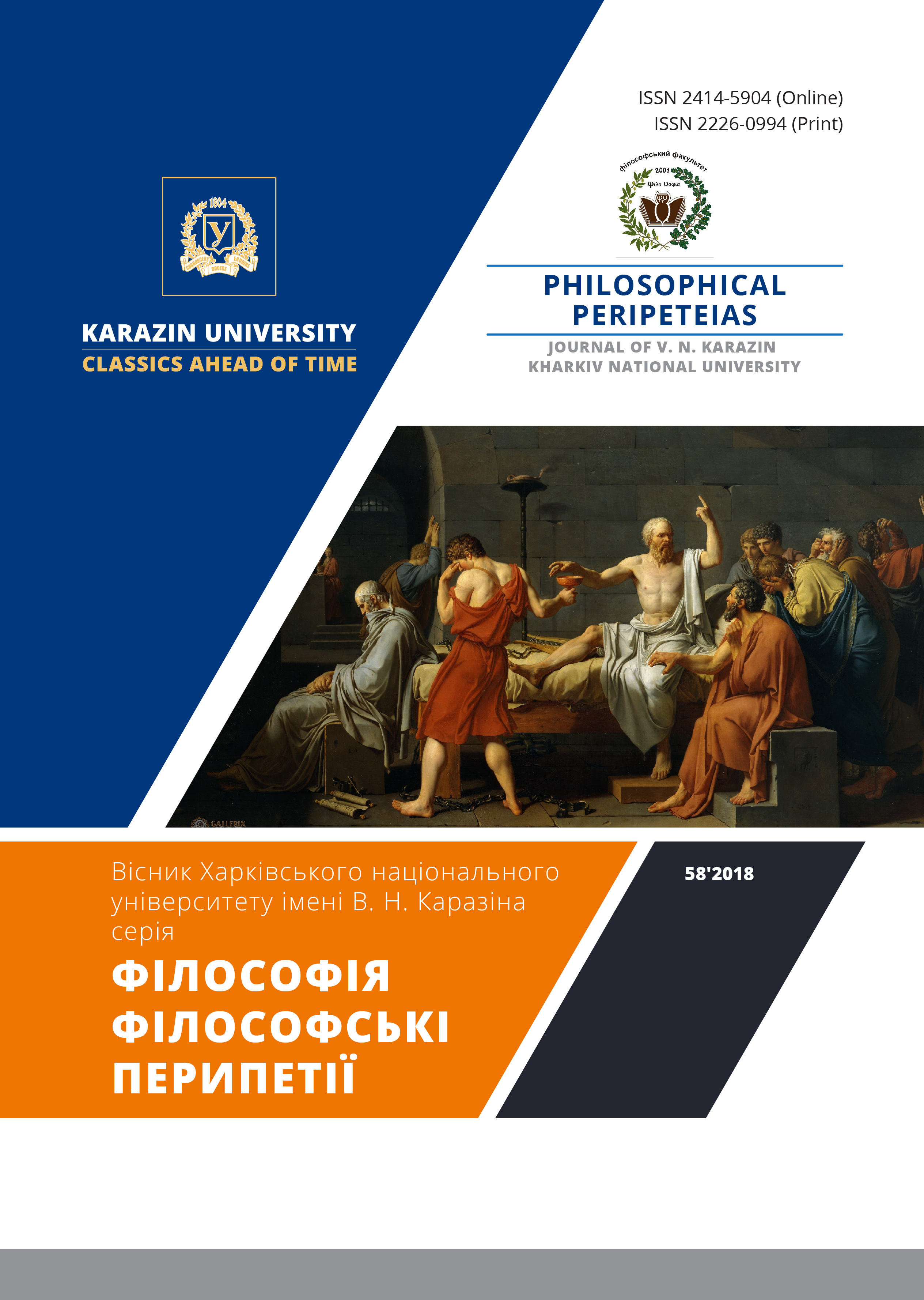ПОСТ-АНТРОПОЦЕННА ГІПОСУБ’ЄКТИВАЦІЯ
Анотація
У статті розглядається гіпосуб’єктивація як найбільш суттєвий вид суб’єктивації у пост-Антропоценному контексті. Гіпосуб’єктивація становить різновид суб’єктивації, яка враховує можливість і необхідність антропологічного ніщо або навіть меншого, ніж ніщо, – не-присутності людської істоти. Порівняно з гіпероб’єктами (від погодних катастроф до селебрітіз), гіпосуб’єкти постають лаканіанською «ламелою», дельозіанським «подвійним віялом сенсації» як продуктивними метафорами або, у більш філософсько-антропологічному формулюванні, моторошним онтологічним «дивним диваком». Пост-антропоценна партикулярізація та сингулярізація людської істоти вводить її у стан не-Всього як іщо, ечі, меньшого, ніж ніщо. І це стан гіросуб’єкта з його контингентністю у n-вимірах, агентурністю, спротиву будь-яким -ізмам, пустотності в дивній реальності. У статті показано, що саме гіпосуб’єкт, «дивний дивак» реалізує шизотратегії заради відкритості людської істоти, яка не-присутня в її меонтичній нищі-вності, або тактики плавлиння як становлення-Природою. Такий підхід розвивається в аспекті не-людського повороту як значущого філософсько-антропологічного напряму. Дослідження ґрунтується на філософії пост-постмодерна, об’єкт-орієнтованої онтології, дивному, агентурному реалізмі інтра-акцій тощо, де людська істота розглядається в багатоманітті її нищі-вності. Філософська антропологія в цьому випадку змикається з глибинною, темною та дивною екологією, а людська істота постає природним об’єктом, що є позбавленим власної природи. Матеріал для дослідження становили актуальні культурні явища, як-от творчість Бйорк, Олафура Еліассона та «A Place of a Bury Strangers», а також відповідні життєві практики в подієвості постпостмодерна. Таким чином стверджується принцип гіпосуб’єктивації людської істоти в пост-Антропоценному контексті.
Завантаження
Посилання
Barad, K. (2003). Posthumanist Performativity: Toward an Understanding of How Matter Comes to Matter. Signs, Spring, 801–831.
Braithwaite, M. (2010). Post-Postmodern Icelandic Shamanism. Retrieved from https://ironingboardcollective.wordpress.com/2010/06/08/post-postmodern-icelandic-shamanism-boho-new-age-need-not-apply.
Benjamin, W. (1979). One Way Street And Other Writings. London: NLB.
Björk, (2015). This huge sunlit abyss from the future right there next to you ... : emails between Björk Guðmundsdóttir and Timothy Morton. In Björk, Archives (Vol. IV). London: Thames and Hudson.
Boyer, D., & Morton, T. (2016, January). Hyposubject. Cultural Anthropology, 21. Retrieved from https://culanth.org/fieldsights/798-hyposubjects.
Clemens, J., & Pettman, D. (2004). Avoiding the Subject. Media, Culture and the Object. Amsterdam: Amsterdam University Press.
Deleuze, G. (2006). The Fold: Leibniz and the Baroque. (T. Conley, Trans.). London: Continuum. (Original work published 1988).
Dolar, M. (2013). The Atom and the Void – from Democritus to Lacan. Filozofski vestnik, XXXIV(2), 11–26.
Grant, I. H. (2000). The Chemistry of Darkness. Pli, 9, 36–52.
Hansen, M. (2015). Our Predictive Condition; or, Prediction in the Wild. In R. Grusin (Ed.), The Nonhuman Turn (pp. 101–138). Minesotta: Minesotta UP.
Morelle, L. (2012). Speculative Realism. After finitude, and beyond? A vade mecum. Speculations, III, 241–272.
Morton, T. (2007). Ecology Without Nature: Rethinking Environmental Aesthetics. Cambridge, MA and London: University Press.
Morton, T. (2013). Hyperobjects: Philosophy and Ecology after the End of the World. Minneapolis: University of Minnesota Press.
Negarestani, R. (2008). Cyclonopedia: Complicity with Anonymous Materials. Melbourn: re.press.
Žižek, S. (2012). Less than nothing: Hegel and the shadow of dialectical materialism. London: Verso.
Автори, які публікуються у цьому журналі, погоджуються з наступними умовами:
- Автори залишають за собою право на авторство своєї роботи та передають журналу право першої публікації цієї роботи на умовах ліцензії Creative Commons Attribution License 4.0 International (CC BY 4.0), котра дозволяє іншим особам вільно розповсюджувати опубліковану роботу з обов'язковим посиланням на авторів оригінальної роботи та першу публікацію роботи у цьому журналі.
- Автори мають право укладати самостійні додаткові угоди щодо неексклюзивного розповсюдження роботи у тому вигляді, в якому вона була опублікована цим журналом (наприклад, розміщувати роботу в електронному сховищі установи або публікувати у складі монографії), за умови збереження посилання на першу публікацію роботи у цьому журналі.
- Політика журналу дозволяє і заохочує розміщення авторами в мережі Інтернет (наприклад, у сховищах установ або на особистих веб-сайтах) рукопису роботи, як до подання цього рукопису до редакції, так і під час його редакційного опрацювання, оскільки це сприяє виникненню продуктивної наукової дискусії та позитивно позначається на оперативності та динаміці цитування опублікованої роботи (див. The Effect of Open Access).






3.gif)




